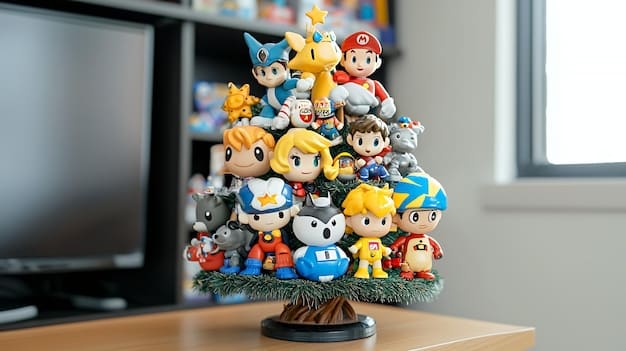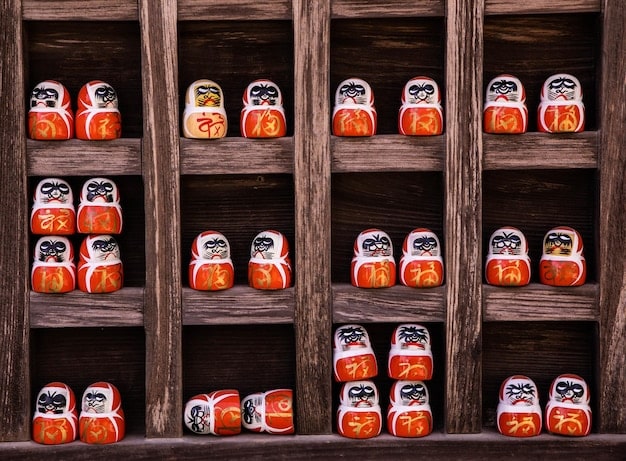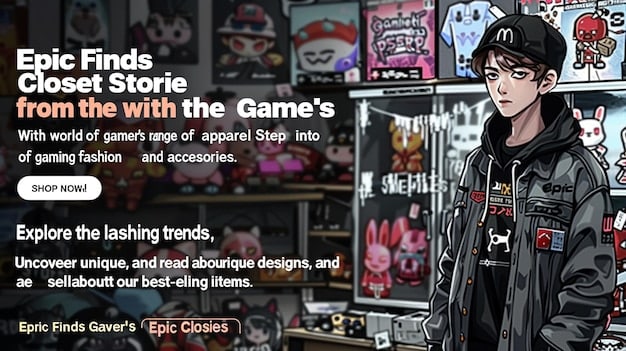The Impact of Anime Licensing on Merchandise Prices for US Buyers

Understanding the impact of licensing on anime merchandise prices is crucial for US buyers, influencing availability, authenticity, and cost.
For US-based anime enthusiasts, the price tags on figurines, apparel, and collectibles can sometimes feel as complex as the storylines themselves. Understanding the impact of licensing on anime merchandise prices: what US buyers need to know is essential for making informed purchasing decisions.
What is Anime Licensing and Why Does it Matter?
Anime licensing is the process by which companies obtain the legal rights to distribute, sell, and market anime-related products outside of Japan. These rights are usually granted by the original Japanese copyright holders, and they play a significant role in determining the availability and cost of anime merchandise in the US.
Licensing serves several crucial functions in the anime merchandise ecosystem. It ensures that the products are authentic and meet certain quality standards. It also provides the copyright holders with compensation for their work, which helps to fund future anime productions. But how does this translate into the prices you see on store shelves?
The Key Players in Anime Licensing
Several companies are prominent in the anime licensing landscape. These include:
- Crunchyroll: Known primarily for streaming anime, Crunchyroll also holds licenses for a wide range of merchandise, making it a one-stop-shop for many US fans.
- Funimation: Another major player in anime streaming and distribution, Funimation also has a robust licensing arm, offering everything from Blu-rays to figures.
- Viz Media: While known for publishing manga, Viz Media also licenses anime for distribution and merchandise, particularly for popular series like Naruto and Sailor Moon.
- Good Smile Company: Specializing in high-quality figures and collectibles, Good Smile Company often collaborates directly with Japanese studios to produce licensed merchandise for global distribution.
Understanding these key players can help you identify reputable sources for your anime merchandise and also understand why prices may vary from one retailer to another.

In conclusion, anime licensing is a complex system with many moving parts. Recognizing the key players and understanding the basic principles can help US buyers navigate the market more effectively and make better-informed purchasing decisions.
How Licensing Affects the Price of Anime Merchandise in the US
The licensing process adds several layers of cost to anime merchandise, which ultimately impacts the price that US buyers pay. These costs stem from various factors, including licensing fees, production costs, distribution expenses, and marketing investments.
Licensing fees alone can significantly increase the cost of merchandise. These fees are paid to the Japanese copyright holders for the right to produce and sell the merchandise in the US. The more popular the anime series, the higher these fees are likely to be.
Factors Influencing Merchandise Pricing
Several factors contribute to the final pricing of anime merchandise:
- Licensing Fees: As mentioned, these fees are a primary driver of cost. Popular anime series command higher licensing fees, which are passed on to the consumer.
- Production Costs: The materials and labor involved in manufacturing anime merchandise can vary widely. High-quality figures made with premium materials will naturally cost more to produce.
- Distribution Expenses: Shipping, warehousing, and handling add to the cost. International shipping, in particular, can be expensive.
- Marketing and Promotion: Companies invest in marketing to create excitement and demand for their products. These expenses are factored into the price as well.
These factors, when combined, determine the final price you see on anime merchandise.
Understanding how licensing affects the price of anime merchandise allows US buyers to better appreciate the value of these products and make informed choices about their purchases.

The Cost of Importing Vs. Buying Licensed Merchandise Domestically
US buyers often face a choice between importing anime merchandise directly from Japan and buying licensed products domestically. Each option has its own set of pros and cons, particularly when it comes to cost.
Importing directly from Japan can sometimes seem like a cheaper option, but the costs can quickly add up. Shipping fees, customs duties, and import taxes can significantly increase the final price. Additionally, there is always the risk of delays or damage during shipping.
Pros and Cons of Importing
Let’s weigh the advantages and disadvantages of importing anime merchandise:
- Pros: Access to exclusive or limited-edition items not available in the US, potentially lower base prices on certain items.
- Cons: High shipping costs, customs duties, import taxes, potential for shipping delays or damage, language barriers, and lack of consumer protection.
Buying licensed merchandise domestically, on the other hand, offers greater convenience and consumer protection. While the prices may be higher, you avoid the hassle and risks associated with importing.
- Pros: Convenience, faster shipping times, consumer protection laws, easier returns, and no customs duties or import taxes.
- Cons: Higher prices, limited selection compared to the Japanese market.
Ultimately, the best choice depends on your individual priorities and budget. If you are looking for rare or exclusive items and are willing to deal with the hassles of importing, then it may be the right option for you. However, if you prioritize convenience and consumer protection, then buying licensed merchandise domestically is likely the better choice.
In conclusion, carefully consider the costs and benefits of both importing and buying licensed merchandise domestically before making a decision. Factor in shipping, customs, and potential consumer protection issues to ensure you are getting the best value for your money.
Spotting and Avoiding Bootleg Anime Merchandise
The anime merchandise market, unfortunately, is plagued by bootleg or counterfeit products that can deceive unsuspecting buyers. These fake items are often of poor quality and can be a waste of money. Learning how to spot and avoid bootleg anime merchandise is essential for protecting your wallet and ensuring you get authentic products.
One of the easiest ways to identify bootleg merchandise is to look for suspiciously low prices. If a deal seems too good to be true, it probably is. Counterfeiters often undercut the prices of legitimate products to lure in buyers.
Red Flags to Watch For
Here are some red flags to watch out for when buying anime merchandise:
- Unusually Low Prices: Significantly lower prices than other retailers are a strong indicator of a bootleg product.
- Poor Quality: Check for imperfections, such as misprinted logos, sloppy paint jobs, and flimsy materials.
- Inconsistent Packaging: Look for inconsistencies in the packaging, such as misspellings, incorrect logos, or missing security features.
- Unofficial Retailers: Be wary of buying from unverified or unknown online retailers. Stick to reputable sources like Crunchyroll, Funimation, and authorized dealers.
By being vigilant and looking for these red flags, you can significantly reduce your risk of buying bootleg anime merchandise.
- Check the seller’s reputation: Look for reviews that mention authenticity.
- Examine product photos closely: Zoom in to check for imperfections or inconsistencies.
- Be wary of “too good to be true” deals: Significantly discounted prices are often a red flag.
In conclusion, spotting and avoiding bootleg anime merchandise requires vigilance and awareness. By looking for the red flags mentioned above and sticking to reputable retailers, US buyers can protect themselves from counterfeit products and ensure they get authentic, high-quality merchandise.
The Role of Exclusives and Limited Editions in Anime Merchandise Pricing
Exclusives and limited editions play a significant role in the anime merchandise market, often commanding higher prices due to their rarity and perceived value. These items are typically produced in limited quantities and may be available only through specific retailers or during special events.
The scarcity of exclusives and limited editions creates a sense of urgency and drives up demand. Collectors are often willing to pay a premium to acquire these items, knowing that they may not be available again.
Understanding The Hype
Several factors contribute to the popularity and pricing of exclusives and limited editions:
- Rarity: The limited production runs make these items highly sought after by collectors.
- Exclusivity: Being available only through specific retailers or events increases their desirability.
- Special Features: Exclusives often come with unique features, such as special packaging, alternate color schemes, or bonus accessories.
US buyers should be aware of these factors when considering purchasing exclusives and limited editions.
- Resale Market: Be prepared to pay inflated prices on the resale market, especially for highly sought-after items.
- Authenticity: Verify the authenticity of exclusives, as counterfeiters often target these products.
- Budget Wisely: Set a budget and stick to it to avoid overspending on collectibles.
In conclusion, exclusives and limited editions are an integral part of the anime merchandise market, driving demand and influencing prices. US buyers should understand the reasons behind their popularity and be aware of the potential risks and rewards before making a purchase.
Future Trends in Anime Merchandise and Licensing
The anime merchandise and licensing market is constantly evolving, driven by technological advancements, changing consumer preferences, and globalization. Several trends are shaping the future of the industry, and US buyers should be aware of these developments.
One of the most significant trends is the growth of online retail and e-commerce. Online platforms make it easier for US buyers to access a wider range of anime merchandise from around the world.
Emerging Trends in the Market
Here are some key trends to watch out for:
- Virtual Merchandise: Digital collectibles and virtual items are becoming increasingly popular, offering new revenue streams for licensors.
- Subscription Boxes: Anime-themed subscription boxes are gaining traction, providing a curated selection of merchandise delivered to your door on a regular basis.
- Collaborations: Partnerships between anime brands and other industries, such as fashion and gaming, are becoming more common, resulting in unique and innovative products.
US buyers can expect to see more of these trends in the coming years.
- Keep an eye on online retailers: E-commerce platforms will continue to dominate the anime merchandise market.
- Explore subscription boxes: These can be a great way to discover new and exciting products.
- Stay informed about collaborations: Look out for partnerships between anime brands and other industries.
In conclusion, the future of the anime merchandise and licensing market is dynamic and full of possibilities. By staying informed about emerging trends, US buyers can take advantage of new opportunities and make the most of their anime merchandise spending.
| Key Aspect | Brief Description |
|---|---|
| 💰 Licensing Fees | Fees paid to copyright holders increase merchandise costs. |
| 🚢 Importing Costs | Shipping, customs, and taxes add to the price of imported items. |
| 🚩 Bootleg Risks | Low-quality fakes flood the market; be cautious and informed. |
| 🎁 Limited Editions | Scarcity and exclusivity drive up prices for rare items. |
Frequently Asked Questions
▼
Licensed merchandise involves fees to copyright holders, ensuring quality but increasing costs. Production, distribution, and marketing expenses are also factored in.
▼
Check for official licensing logos, high-quality materials, and consistent packaging. Buy from reputable retailers and be wary of unusually low prices.
▼
Importing can sometimes seem cheaper, but shipping costs, customs duties, and import taxes can quickly add up. Consider domestic options for convenience and safety.
▼
Bootleg merchandise is often of poor quality, lacks detail, and may infringe on copyright laws. You risk wasting money on inferior and potentially illegal products.
▼
Limited editions are produced in small quantities, making them rare and highly sought after. This scarcity drives up demand and prices, especially on the resale market.
Conclusion
Understanding the nuances of anime merchandise licensing empowers US buyers to make informed decisions. By considering the factors that influence pricing, recognizing authentic products, and staying aware of market trends, fans can navigate the anime merchandise landscape with confidence and get the most value for their money.





